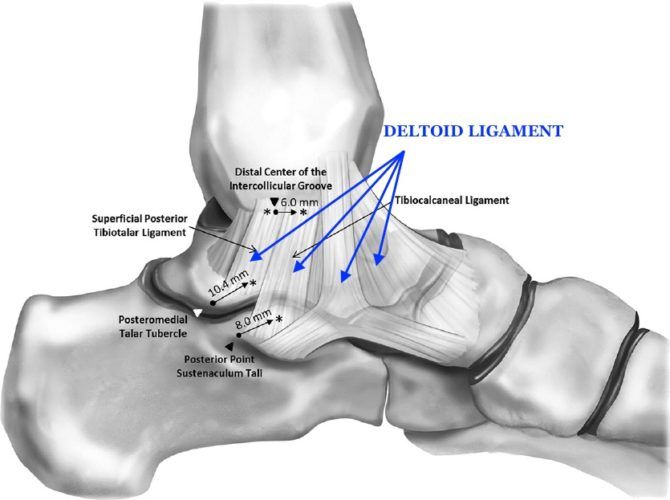
What exactly have you injured when you sprain your ankle?
Ankle injuries are extremely common. They occur in people of all ages, and the most common ankle injury is an ankle sprain. The term ‘sprain’ is frequently used to describe a ‘soft tissue’ injury, where the bones around the ankle have not fractured, however the ligaments and capsule that surround the joint are injured. With the ankle sprain being so common, it is time to take a look at what the ankle ligaments are, and which ones are frequently injured at the time of injury

Lateral (Outer) Ankle Ligaments
The majority of ankle sprains occur due to a twisting inversion injury, where the foot buckles inwards, beneath the tibia. This ‘inversion’ mechanism of injury results in an injury and tearing to the lateral ankle ligaments. These ligaments are found on the outer aspect of the ankle joint and function to prevent excessive inversion. There are three main lateral ankle ligaments:
Anterior Talofibular Ligament (ATFL)
Posterior Talofibular Ligament (PTFL)
Calcaneo-fibular Ligament (CFL)

The ATFL passes from the front of the tip of the fibula to the talar neck. It is the most frequently torn ankle ligament. the ATFL is a relatively week ligament and is largely responsible for preventing ankle inversion when the ankle is plantar flexed (Toes pointing down)
The CFL is the next most commonly injured ankle ligament. When injured, the CFL is usually injured in combination with the ATFL. This typically represents a more severe injury.
The PTFL is a rarely injured ligament. When ruptured, it is almost always in combination with the ATFL and CFL.
Medial (Inner) Ankle Ligaments
The medial ankle ligament is also called the deltoid ligament. The term deltoid is used to describe the triangular shape of this ligament. It takes origin from the tip of the medial malleolus (lower inner part of the tibia) and spreads out distally to have attachments to many of the hindfoot bones.
The deltoid ligament can occur in isolation, or in combination with a lateral sided injury (soft tissue or fracture). Typically an ‘eversion’ type of injury results in a torn deltoid ligament. These injuries occur when the foot rolls ‘out’ as part of the injury.


Proximal (High) Ankle Ligaments
You may have heard of the term a ‘high’ ankle sprain. This phrase has been recently used to describe an injury to the ligaments ‘above’ the ankle joint (i.e closer to the knee). These ligaments are referred to as the syndesmosis ligaments and are responsible for the normal relationship between the lower end of the tibia and the fibula.
High ankle sprains are much less common than a standard ankle sprain. However their impact is significant, with a longer recovery and more chance of requiring surgery for optimal results.
The ‘syndemosis’ is formed by a combination of ankle ligaments, including:
Anteroinferior Tibiofibular Ligament (AITFL)
Posteroinferior tibiofibular Ligament (PITFL)
Interosseous Ligament
A High ankle sprain usually occurs by one of two ways.
Either the planted foot undergoes excessive external rotation, or if the ankle joint is significantly loaded into dorsiflexion.
As you can see, the ligaments surrounding the ankle joint are complex.
The majority of ankle ligamentous injuries will heal well with functional rehabilitation. Early assessment to exclude a more ‘complex’ sprain is recommended.

